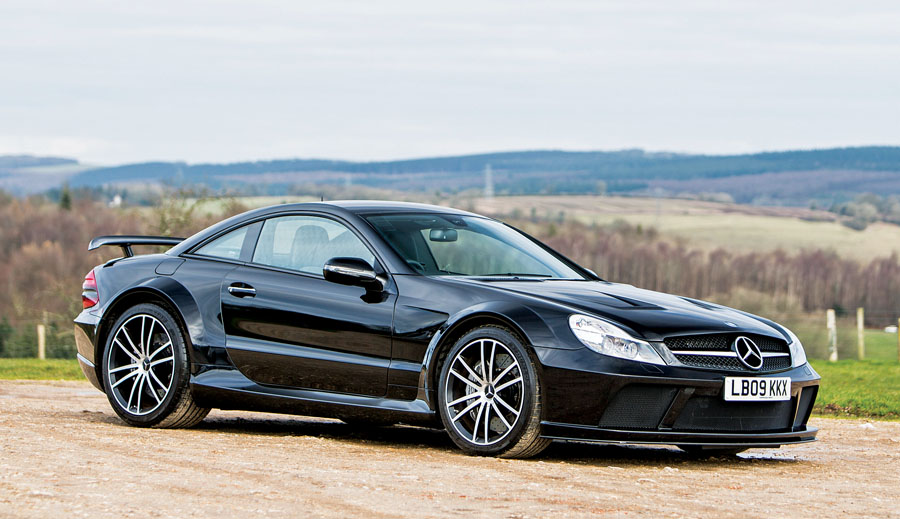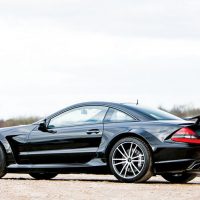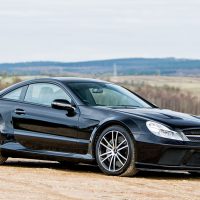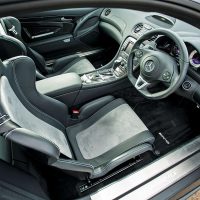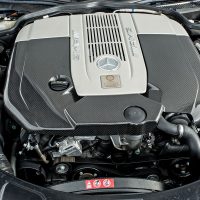SCM Analysis
Detailing
| Vehicle: | 2009 Mercedes-Benz SL65 AMG Black Series |
| Years Produced: | 2008–11 |
| Number Produced: | 350 |
| Original List Price: | $301,750 |
| SCM Valuation: | Median to date, $209,000; high sale, $294,235 |
| Chassis Number Location: | Behind passenger’s seat, underneath parcel-shelf cover |
| Engine Number Location: | Rear left side of engine behind cylinder head |
| Club Info: | Mercedes-Benz Club of America |
| Website: | http://www.MBCA.org |
| Alternatives: | 2011–12 Aston Martin DBS Carbon Black, 2009–15 Mercedes-Benz AMG SLS, 2004–10 Mercedes-Benz SLR McLaren, 2010 Porsche 911 GT2 RS |
| Investment Grade: | B |
This car, Lot 57, sold for $294,235, including buyer’s premium, at Bonhams’ Goodwood Members Meeting Auction in Chichester, U.K., on March 20, 2016.
Before we delve into the theory behind the sale of this SL65 Black Series, which sold for three times (or more) as much as a normal SL65 in this condition would have brought, I need to ask a philosophical question: Does exclusivity actually create long-term commercial value?
To answer this, we need to begin with the socio-economic history of the AMG brand.
AMG in the 1980s
A long time ago, Mercedes-Benz AMGs were a wild and varied bunch of cars — some had cosmetic enhancements and others had serious engine modifications.
At the top of the 1980s heap was the Mercedes-Benz AMG Hammer, with a 4-cam, 6-liter version of the Mercedes M117 V8. These were conservatively rated at 350 horsepower, but the real number was closer to 425.
Back then, any Mercedes with this “Tiermotor” was a machine to be feared, and any 4-cam AMG car that released its filthy shower of hydrocarbons on, say, your twin-kidney grille, was something you would never forget.
Not only was each example highly individualized (and I am not simply referring to the addition of a spoiler kit), but a real AMG with a 4-cam M117 engine alone cost the equivalent of a brand-new Mercedes W126 or W107. Have I just described exclusivity?
Life after the merger
Mercedes set up a sales partnership with AMG in 1990, and some pretty exciting models followed. These included the E36 sedan, coupe and wagon, the E60 sedan, the SL73 and a run of other hairy-chested hot rods. I would include the C36 and the C43 in this list, but you can find a good example of the W202 with little effort, so they aren’t as exclusive as the aforementioned models.
Economically, things were making sense for both parties, so DaimlerChrysler bought out AMG in 1999. After that, the mundane set in, and AMG models became easily attainable, costing little more than a regular Mercedes sedan.
Mercedes-Benz AMG cars are still fast, marvelously constructed vehicles, but they are not exclusive. The used-car values of these newer AMGs are very close to standard-production Mercedes, meaning they do not have long-term commercial value. They have not retained the hype and mystique of the pre-merger AMGs either, as they simply don’t look any different from the rest of the model line.
To underline all this, all modern, mass-produced AMGs are assembled in house with the rest of Mercedes-Benz’s current models.
AMG descends to the Camry-sphere
The minds at AMG made the prudent decision to reassert the unique nature of their product. While the current AMG models were selling like hot cronuts on a Saturday morning, the whole model range had become confusing (and is still confusing).
The goal was to build an AMG for everyone, which ultimately lowered the brand to what I call the Camry-sphere, aka The Universe of Mundane, Everyday Cars. While current owners of these AMG hot rods might disagree, my 1985 300CD garners more excitement than the majority of my MBCA friends’ modern AMG products.
To satisfy the clientele who expected an exclusive AMG product, a super-expensive, super-fast, über-AMG was urgently required.
The result was the Black Series. Did Mercedes create a product with staying power, or was this another creative marketing gimmick?
It’s still not apparent if the Black Series — made from 2008 through 2011 — is different enough to make it worth $200,000 more than a normal SL65. The exceptional characteristic that the Black Series has going for it, in my opinion, is its sinister-sounding name, so we will begin there. If you look at automotive nomenclature, “Black Series” sounds just as good as “Miura,” “Tour de France” or “M1.”
Factually speaking, a 10% performance improvement at this level is useful, but historically, a slight tweak in engine output and a stiffer suspension have never generated extreme positive movement in value on a Mercedes.
A mighty step above the usual AMG
Other than the name and the extra power, the Black Series is endowed with some cosmetic enhancements, a welded-on hard top and a useful amount of weight reduction. I will argue all day long that this is a talented kid brother to the SLR McLaren, and if we see this SL65 as a member of the SLR/SLS family, then suddenly our value perception is significantly altered.
Ultimately, no one can deny that this car exhibits enough machismo to significantly differentiate it from a normal, run-of-the-mill SL65.
The exclusivity that the Black Series exudes places it in a category of Mercedes-Benz vehicles that simply transcend the conventional market — much like its ancestor, the 4-cam, 6-liter Hammer, did in 1986.
While some depreciation will inevitably occur (especially if our subject car leaves the U.K.), I would rather gamble a $100,000 loss on this car than take the inevitable $50,000 hit on a normal AMG product (which, if you own a modern AMG, is currently in progress).
This car was well bought and sold because speed and exclusivity never go out of style. ♦
(Introductory description courtesy of Bonhams.)
